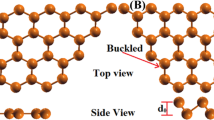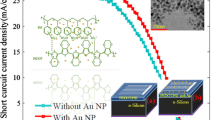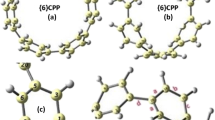Abstract
Recent nanoscience and technology are rapidly progressing with both experimental and theoretical surveys to discover and propose new materials in the fields of semiconductors, optoelectronics, etc. So, in this research, titled physical performances of bulk and monolayered gold cyanides (AuCN) were addressed via density functional theory. Wide indirect semiconductor bandgaps of 2.48 eV and 4.06 eV were obtained for bulk and monolayered AuCN, respectively. Obtained optical characteristics were found to be complex in nature depending mostly on crystal structures of bulk and monolayered crystals and the incident polarization direction. Further, both bulk and monolayer counterparts of AuCN intend alternative materials for applied microelectronics due to their low-dielectric constants below 1.5. Both bulk and monolayered AuCN can be also used as possible functional solar cell components because of their infrared (IR) conductivities. Similarly, both structures were found to be good optical absorbents for ultraviolet applications. Unlike monolayered AuCN, bulk AuCN was found to be a high-refractor material for practical IR goals. Calculated phonon dispersion curves with positive frequencies express the potential experimental synthesis of the addressed compounds. High Seebeck coefficients with 2800 × 10−6 V/K for bulk AuCN and 2700 × 10−6 V/K monolayered counterpart promote the possible fabrication of new thermoelectric materials from these compounds.





Similar content being viewed by others
Availability of data and materials
The datasets generated during and/or analyzed during the current study are available from the corresponding author on reasonable request.
References
Lemme MC, Akinwande D, Huyghebaert C, Stampfer C (2022) 2D materials for future heterogeneous electronics. Nat Commun 13:1–5
Kaushal P, Khanna G (2022) The role of 2-Dimensional materials for electronic devices. Mater Sci Semicond Process 143:106546
Yu W, Gong K, Li Y, Ding B, Li L, Xu Y, Wang R, Li L, Zhang G, Lin S (2022) Flexible 2D materials beyond graphene: synthesis, properties, and applications. Small 18:2105383
Tsai H-S, Wang Y, Liu C, Wang T, Huo M (2022) The elemental 2D materials beyond graphene potentially used as hazardous gas sensors for environmental protection. J Hazard Mater 423:127148
Serafini P, Milani A, Tommasini M, Castiglioni C, Proserpio DM, Bottani CE (2022) Casari CS : Vibrational properties of graphdiynes as 2D carbon materials beyond graphene. Phys Chem Chem Phys 24:10524–10536
Lozovoy KA, Izhnin II, Kokhanenko AP, Dirko VV, Vinarskiy VP, Voitsekhovskii AV, Fitsych OI, Akimenko NY (2022) Single-element 2D materials beyond graphene: methods of epitaxial synthesis. Nanomaterials 12:2221
Jariwala D, Marks TJ, Hersam MC (2016) Mixed-dimensional van der Waals heterostructures. Nat Mater 16:170–181
Lew AJ, Buehler MJ (2021) A deep learning augmented genetic algorithm approach to polycrystalline 2D material fracture discovery and design. Appl Phys Rev 8:041414
Jana S, Bandyopadhyay A, Datta S, Bhattacharya D, Jana D (2021) Emerging properties of carbon based 2D material beyond graphene. J Phys Condens Matter 3:053001
Barraza-Lopez S, Xia F, Zhu W, Wang H (2020) Beyond Graphene: Low-Symmetry and Anisotropic 2D Materials. J Appl Phys 128:40401
Jiang L, Zhou D, Yang J, Zhou S, Wang H, Yuan X, Liang J, Li X, Chen Y, Li H (2022) 2D single- and few-layered MXenes: synthesis, applications and perspectives. J Mater Chem A 10:13651–13672
Javed MS, Mateen A, Ali S et al (2022) The emergence of 2D MXenes based Zn-ion batteries: recent development and prospects. Small 18:2201989
Saeed MA, Shahzad A, Rasool K et al (2022) 2D MXene: a potential candidate for photovoltaic cells? A critical review. Adv Sci 9:2104743
Yang R, Fan J, Sun M (2022) Transition metal dichalcogenides (TMDCs) heterostructures: optoelectric properties. Front Phys 17:43202
Singh AK, Kumar P, Late DJ et al (2018) 2D layered transition metal dichalcogenides (MoS2): synthesis, applications and theoretical aspects. Appl Mater Today 13:242–270
Li S, Ma Y, Ouedraogo NAN et al (2021) p-/n-type modulation of 2D transition metal dichalcogenides for electronic and optoelectronic devices. Nano Res 15:123–144
Jang J, Lee Y, Yoon J-Y et al (2018) One-dimensional assembly on two-dimensions: AuCN nanowire epitaxy on graphene for hybrid phototransistors. Nano Lett 18:6214–6221
Bowmaker GA, Kennedy BJ, Reid JC (1998) Crystal structures of AuCN and AgCN and vibrational spectroscopic studies of AuCN, AgCN, and CuCN. Inorg Chem 37:3968–3974
Hibble SJ, Wood GB, Bilbé EJ et al (2010) Structures and negative thermal expansion properties of the one-dimensional cyanides, CuCN, AgCN and AuCN. Z Kristallogr 225:457–462
Velasco-Arias D, Mojica R, Zumeta-Dubé I et al (2021) New understanding on an old compound: insights on the origin of chain sequence defects and their impact on the electronic structure of AuCN. Eur J Inorg Chem 2021:3742–4375
Hasnip PJ, Refson K, Probert MIJ et al (2014) Density functional theory in the solid state. Philos Trans R Soc A 372:20130270
Clark SJ, Segall MD, Pickard CJ et al (2005) First principles methods using CASTEP. Kristallogr Cryst Mater 220:567–570
Segall MD, Lindan PJD, Probert MJ et al (2002) First-principles simulation: ideas, illustrations and the CASTEP code. J Phys Condens Matter 14:2717–2744
Perdew JP, Burke K, Ernzerhof M (1996) Generalized gradient approximation made simple. Phys Rev Lett 77:3865–3868
Li X, Zhao W, Dong X (2021) A new CG algorithm based on a scaled memoryless BFGS update with adaptive search strategy, and its application to large-scale unconstrained optimization problems. J Comput Appl Math 398:113670
Güler E, Güler M (2014) Phase transition and elasticity of gallium arsenide under pressure. Mater Res 17:1268–1272 (and references therein)
Vanderbilt D (1990) Soft self-consistent pseudopotentials in a generalized eigenvalue formalism. Phys Rev B 41:7892–7895
Monkhorst HJ, Pack JD (1976) Special points for Brillouin-zone integrations. Phys Rev B 13:5188–5192
Madsen GKH, Carrete J, Verstraete MJ (2018) BoltzTraP2, a program for interpolating band structures and calculating semi-classical transport coefficients. Comput Phys Commun 231:140–145
Yelgel C, Yelgel ÖC, Gülseren O (2017) Structural and electronic properties of MoS2, WS2, and WS2/MoS2 heterostructures encapsulated with hexagonal boron nitride monolayers. J Appl Phys 122:065303
Bradley RS, Munro DC, Spencer PN (1969) The effects of very high pressure on AuCN. Phys Stat Sol (b) 36:K51–K53
Korabel’nikov DV, Fedorov IA, Zhuravlev YN (2021) Compressibility and electronic properties of metal cyanides. Phys Solid State 63:1021–1027
Uğur Ş, Güler M, Uğur G, Güler E (2021) Elastic, mechanical, optical and magnetic properties of Ru2MnX (X = Nb, Ta, V) Heusler alloys. J Magn Magn Mater 523:167614
Güler E, Güler M, Uğur Ş, Uğur G (2021) DFT aspects of the elastic, mechanical, magnetic, thermodynamic and optical properties of Ce3XY perovskites. Philos Mag 102:244–263
Güler M, Uğur Ş, Uğur G, Güler E (2021) First principles study of the electronic, optical, elastic and thermoelectric properties of Nb2WNi alloy. Mol Phys 119:e19283
Güler E, Uğur Ş, Güler M et al (2022) Revealing the electronic, optical, phonon and thermoelectrical characteristics of bulk and monolayered RbLiS and RbLiSe compounds by DFT. J Phys Chem Solids 170:110972
Cassabois G, Valvin P, Gil B (2016) Hexagonal boron nitride is an indirect bandgap semiconductor. Nature Photon 10:262–266
Gupta MK, Singh B, Mittal R et al (2016) Lattice dynamics and thermal expansion behavior in metal cyanides, MCN (M=Cu, Ag, Au): neutron inelastic scattering and first principles calculations. Phys Rev B 93:134307
Zaleski-Ejgierd P, Hakala M, Pyykkö P (2007) Comparison of chain versus sheet crystal structures for the cyanides MCN (M=Cu–Au and dicarbides MC2 (M=Be–Ba, Zn–Hg). Phys Rev B 76:094104
Chippindale AM, Hibble SJ, Bilbé EJ et al (2012) Mixed copper, silver, and gold cyanides, (MxM′1–x) CN: tailoring chain structures to influence physical properties. J Am Chem Soc 134:16387–16400
Jha PK, Soni HR (2014) Strain induced modification in phonon dispersion curves of monolayer boron pnictides. J Appl Phys 115:023509
Xu Z, Li Y, Liu Z (2016) First-principles calculations of structural, electronic, and thermodynamic properties of monolayer Si1−xGexC sheet. RSC Adv 6:113903
Choudhary K, Garrity KF, Reid ACE et al (2020) The joint automated repository for various integrated simulations (JARVIS) for data-driven materials design. NPJ Comput Mater 6:173
Funding
The authors declare that no funds, grants, or other support were received during the preparation of this manuscript.
Author information
Authors and Affiliations
Contributions
GU, MG, ŞU and EG have directly participated in the planning, execution and analysis of this study. EG drafted the manuscript. All authors have read and approved the final version of the manuscript.
Corresponding author
Ethics declarations
Competing interests
The authors declare no competing interests.
Conflict of interest
The authors declare that they have no conflict of interest.
Ethical approval
Not applicable.
Additional information
Publisher's Note
Springer Nature remains neutral with regard to jurisdictional claims in published maps and institutional affiliations.
Rights and permissions
Springer Nature or its licensor (e.g. a society or other partner) holds exclusive rights to this article under a publishing agreement with the author(s) or other rightsholder(s); author self-archiving of the accepted manuscript version of this article is solely governed by the terms of such publishing agreement and applicable law.
About this article
Cite this article
Uğur, G., Güler, M., Uğur, Ş. et al. DFT exploration of the electronic, optical, phonon and thermoelectrical performances of bulk and monolayered AuCN. Theor Chem Acc 142, 20 (2023). https://doi.org/10.1007/s00214-023-02960-7
Received:
Accepted:
Published:
DOI: https://doi.org/10.1007/s00214-023-02960-7




